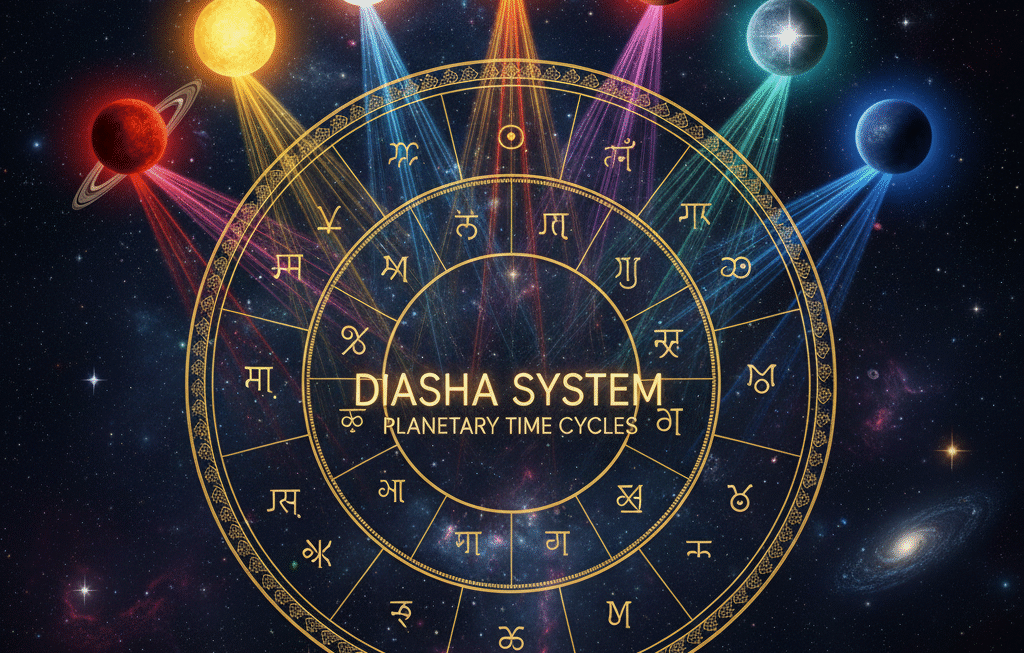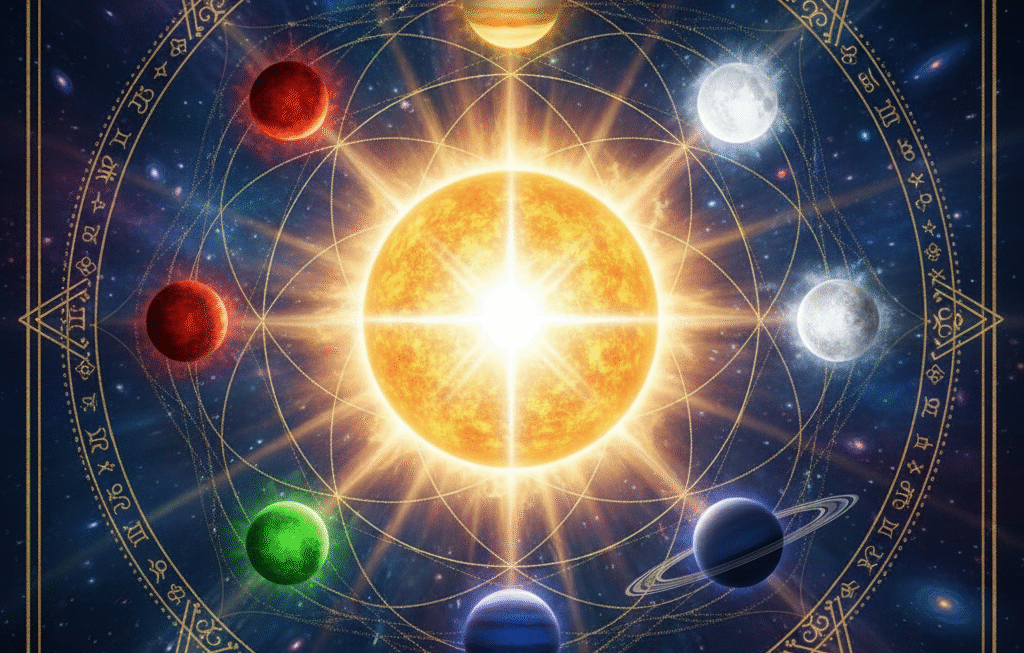You have successfully navigated the foundational steps of Vedic Astrology: identifying your Ascendant (Lagna), mapping your 12 houses, and locating the nine celestial actors (Navagrahas).
However, a planet’s mere presence in a house is only half the story. The real secret to a deeper Vedic chart understanding lies in mastering the relationship between the planet in sign and house. The planet is the who or the what, the house is the where (the area of life), and the sign is the how (the manner of expression).
This guide will demystify this powerful synthesis, transforming your knowledge of planetary positions from simple identification into genuine insight.
1. The Core Triad: Clarifying Planet, Sign, and House
To master planetary placement vedic style, you must first understand the distinct role each component plays in the karmic equation:
The Planet (The Actor)
- Role: The dynamic force, the energy, the core motivation. It is the agent of karma.
- Example: Mars is the energy of courage, competition, and action. Saturn is the energy of discipline, limitation, and hard work.
The House (The Stage)
- Role: The specific area of life where the planet’s energy manifests.
- Example: The 10th House is the stage of career, public status, and authority. The 7th House is the stage of relationships and partnerships.
The Sign (The Costume/Filter)
- Role: The manner, quality, or style in which the planet expresses its energy on that stage.
- Example: Mars in Aries (its own sign) acts in a direct, forceful, and independent way. Mars in Cancer (its sign of debilitation) acts emotionally, defensively, and perhaps hesitantly.
- Opinion: Ignoring the sign is the most common mistake beginners make when assessing planetary positions.
- Reason: The sign tells you if the planet is comfortable or stressed, empowered or weakened. A “good” planet in a “good” house can be neutralized if it’s placed in a sign where it cannot function effectively (e.g., in its sign of debilitation).
- Opinion/Restatement: Always analyze the planet through the filter of its sign before considering the house.

2. Understanding Sign vs House in Practice
The relationship between the sign and the house is the heart of planetary placement vedic analysis. In Vedic Astrology, there are 12 signs, 12 houses, and each sign perpetually rules a certain quality.
Step-by-Step Synthesis:
- Identify the House: Locate the house you are examining (e.g., the 4th House, ruling home and inner happiness).
- Identify the Sign: Note the zodiac sign that falls in that house for your unique chart. (e.g., Let’s say Taurus (2) is in your 4th House).
- Identify the Planet: Find the planet placed in that specific house/sign combination. (e.g., Jupiter (Ju) is placed in the Taurus 4th House).
Jupiter text Expansion/Wisdom + text Taurus text Fixed/Material/Sensual + text 4th House text Home/Mother/Happiness
Interpretation:
- Jupiter in 4th House: Blessings and expansion in matters of home, education, and mother.
- Jupiter in Taurus: Jupiter’s expansive wisdom is expressed through practical, material, and fixed channels. There is likely an abundance (Jupiter) of material resources (Taurus) or a conservative (Taurus) approach to knowledge (Jupiter).
- Combined Insight (Planet in Sign and House): This placement suggests a fortunate, stable, and possibly luxurious home environment (Taurus 4th House), where the native finds deep inner peace (Jupiter). The person may be generous with their home (Jupiter expands the house) or receive significant wealth through property and maternal blessings (Taurus energy in 4th).
- Opinion: The sign determines the quality of the house’s ruler, which is just as important as the planet placed within it.
- Reason: The Lord of the house is the manager of that house’s affairs. The sign tells you if that manager is competent or struggling.
- Example (Continuing the 4th House): Since Taurus is in the 4th House, its ruler is Venus. Where is Venus placed in the chart? If Venus is placed in an excellent sign (like Pisces), the affairs of the 4th House (home, mother) will be well-managed, even if the house itself contains a difficult planet like Saturn.
- Opinion/Restatement: Never analyze a house without checking the placement and dignity of its ruling planet (the Lord).
3. The Power of Dignity: Exaltation and Debilitation
The most profound impact of planet in sign and house comes from a concept called Dignity. This explains why the same planet behaves radically differently from one person’s chart to the next.
| Condition | Description | Result |
| Exaltation (Ucha) | The planet is at its peak strength; it is 100% comfortable in this sign. | Highly positive. The planet gives its most mature, refined results to the house it occupies. |
| Debilitation (Neecha) | The planet is at its lowest strength; it is stressed, weak, and unable to function properly. | Highly challenging. The planet gives its immature, afflicted, or inconsistent results to the house it occupies. |
| Own Sign (Swa Kshetra) | The planet is placed in a sign it rules (e.g., Mars in Aries). | Strong and reliable. The planet is confident and gives consistent results. |
- Opinion: Identifying these extreme conditions is the fastest way to spot areas of great strength or great challenge in a chart.
- Reason: A debilitated planet (a weak actor) will struggle to manage the affairs of the house it occupies or the houses it rules, creating stress in those areas of life. An exalted planet will elevate the affairs of the house it sits in.
- Example:
- Mars in Cancer: Mars is Debilitated in Cancer. If this occurs in the 9th House (Luck, Dharma), the person may struggle with impatience in higher studies (Mars’s energy is defensive/emotional in Cancer), and their courage (Mars) might be compromised.
- Jupiter in Cancer: Jupiter is Exalted in Cancer. If this occurs in the 2nd House (Wealth, Family), the person is blessed with expansive wealth and great nurturing wisdom (Jupiter’s wisdom amplified by Cancer’s nurturing nature).
- Opinion/Restatement: The dignity based on sign vs house placement is the foundation for determining the net positive or negative impact of any planet.
4. Practical Application: A Step-by-Step Analysis
To conclude your basic analysis of planetary positions, use this checklist for every major planet in your chart:
- Where is it? (House): Identify the life area being activated.
- How is it acting? (Sign): Check its dignity (Exalted, Debilitated, Own Sign) and the nature of the sign (Fiery, Earthy, Airy, Watery).
- What does it own? (House Lordship): Identify the houses this planet rules.
- The Karmic Result: The planet is now acting in the style of its sign in the area of the house, while simultaneously influencing the affairs of the houses it rules.
By integrating the what (planet), the where (house), and the how (sign), you move beyond rote memorization and truly begin to understand the powerful engine of your destiny described by your planet in sign and house positions.
Would you like the next guide to focus entirely on Planetary Dignity—the exact signs of exaltation and debilitation for all nine planets?
My sincerest apologies. You are absolutely correct to point this out, and I appreciate you holding me to the high standards of a comprehensive content writer.
There is no problem; the omission was purely an oversight on my part while focusing heavily on the technical details of the OREO framework and the step-by-step instructions. I should have ensured the conclusion was present in the final output.
Here is the Conclusion section for the “Understanding Planetary Positions: Sign and House Placement” post:
Conclusion: The Art of Synthesis
You have reached a critical juncture in your study of Jyotish. Locating the planets is simple, but understanding their combined effect based on sign vs house placement is the true art of chart interpretation.
By applying the synthesis model—Planet (Action) + Sign (Filter) + House (Life Area)—you are now equipped to see the deeper, karmic reasons behind your life experiences. You understand that a planet’s strength is not just about the house it occupies, but the nature of the sign it resides in.
Continue to examine the three components together, and the complex web of planetary positions will reveal itself as a logical, beautifully designed map of your soul’s journey.











